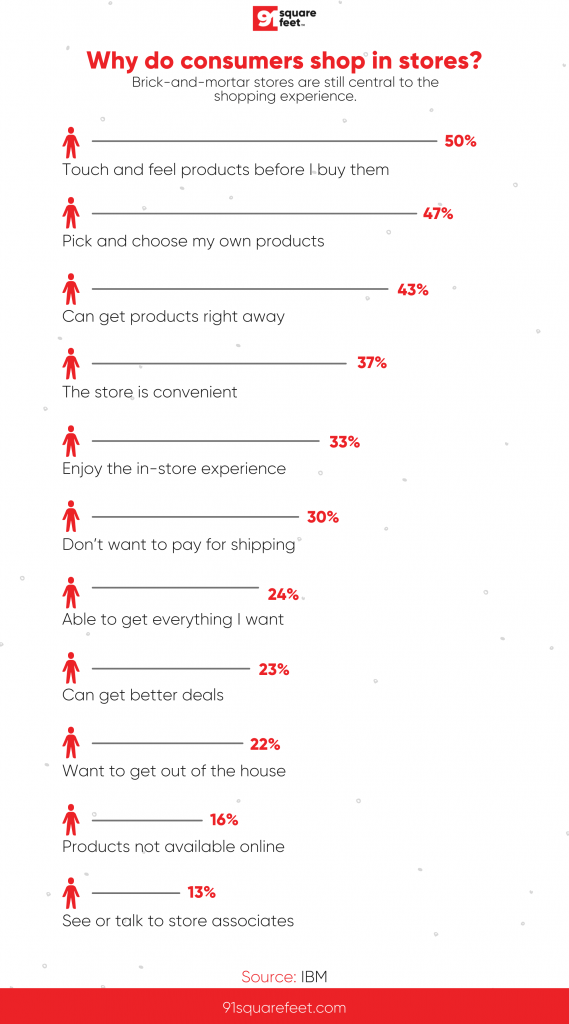Today, E-Commerce has become synonymous with technological advancement, and doorstep delivery has become the shopping norm. Yet one persistent question remains: why do we still see crowds in offline retail stores?
The answer is multi-faceted. 2021 witnessed 750 million smartphone users, touted to be a billion strong by 2026. Each of those 750 million people has access to E-Commerce sites and apps, so logically we should never see anyone in offline stores anymore.
Yet, the reality is quite different.
In this post, we have narrowed down the plausible reasons why brands say a resounding “Yes!” to offline retail even in 2023.
If you are an offline retail shopper, you will relate to most of these, and that is where the strength of offline commerce lies.
Why do Brands say Yes to Offline Retail in 2023?
According to a survey, 2020 saw a mere 3.6% of retailing happening online. Let’s look at the top 8 reasons why people (and hence, brands) are still choosing offline retail:
1. No Waiting Time for Delivery
Imagine wanting a bag for months but not being able to afford it. When you finally have the means to go for it and place the order excitedly, a prompt informs you that you must now wait for 7 to 10 business days to receive it.
Naturally, the enthusiasm fizzles over the week, and when it finally arrives after 7 days without warning, it does not feel the same anymore.
Juxtapose that with heading out to the nearest store with your friends and instantly grabbing the bag you want. No waiting time, no unpredictable delivery! This is one of the most common reasons why brands encourage offline shopping.
Alternatively, let’s say you need some medical equipment immediately, and the online order screen predicts a week-long waiting time till it arrives. Wouldn’t you instead make the short trip to the store and get it?
By the time the online order arrives, chances are your emergency will be a thing of the past. In cases of immediacy, nothing beats the convenience of offline retail stores.
2. Firsthand Experience with the Product
We can all concur that we would find much more satisfaction in online shopping if we could avail options for trying them out first-hand. But with online commercial modes, first-hand experience is logically impossible.
However, offline retail stores still hold the customers’ trust with their options to try on your favourite attires or pick up the desired item and toss it around in your hands for a while to get the “feel” of it.
It does not get better than being able to hold the item you plan to purchase and trying it out to understand how it works.
Brands know that customer trust is a significant factor in sales, so they encourage offline shopping to establish faith in their products as customers see the items first-hand and decide for themselves whether they approve.
3. Availability of Sales Staff Nearby
When shopping online, you are on your own, and there isn’t much in the name of a helping hand that can vouch for the quality or clarify your doubts about the products.
While in the case of offline shopping, you can get all your genuine and personal queries clarified with the sales staff at your disposal.
Purchasing any product requires considerable decision-making regarding the pros and cons and, most importantly, whether it meets your specific needs. With a sales staff, it becomes easier to understand the true nature and purpose of the product you want to buy.

Brands want to encourage your doubts and create an atmosphere of transparency. This helps avoid cases of dissatisfaction and product returns- both detrimental to the brand’s image. With offline retail, brands have a way of maintaining customer loyalty.
4. Fewer Privacy Concerns and Risks
Chargebacks and fraudulent transactions account for less than 1% of all global exchanges, but the rate is considerably higher for E-Commerce. And it is growing!
E-Commerce brands offering physical products should witness a chargeback ratio of 0.10% to 0.30%, with a little over half of that expectedly fraudulent. Chargeback fraud is a pressing issue in the online commerce sphere.
For those who do not know, chargeback fraud occurs when a customer makes an online purchase but requests a chargeback from the issuing bank following the receipt of the purchased goods.
With offline retail shopping, brands tackle this issue better. From a consumer’s perspective, it is always in their best interest to avert the risks of trusting online transactions with an unknown seller rather than the assurance and security of making payments to a seller right before you.
This is especially true considering the waiting time for online shopping. Until the product arrives at your doorstep, there are always some chances of fraud.
5. No Delivery or Shipping Costs
This one is straightforward. Shop online, and pay the extra delivery and shipping costs. Alternatively, drop in at your nearest offline retail store and avoid additional charges!
Delivery and shipping charges, often known as convenience charges, can pile up to the point of reconsidering your purchase unless you have a subscription with the brand.
Either way, you must shell out some extra dough to ensure timely delivery.
Even if you pay your delivery charge, your item can still be delayed due to unforeseen circumstances. All in all, it is neither financially feasible nor generally gratifying.
6. Open to the Non-Tech-Savvy
While you might have bought a smartphone for your parents and grandparents, that does not necessarily translate to them becoming tech-savvy overnight.
For the older generation and the rare yet thriving non-tech-savvy youth demographic, it is always better to visit an offline retail store instead of struggling with the nitty-gritty of the technological world.
Virtual size charts, quality control, payment getaways, address books, and phone numbers are not the easiest to manage if you are not fluent in technology.
So, for a significant part of the population, it is in their best interest to opt for the more convenient offline stores rather than trying to manoeuvre around E-Commerce.
7. Bargaining Possibilities
Depending on which offline retail stores you visit, there’s a slight possibility of a bargain. You can get your favourite products at prices lower than the M.R.P. solely because of your bargaining skills.
This will be next to impossible with E-Commerce sites and apps. In online shopping, you pay however much is mentioned, and there is no other way to do it. Sure, not all offline retail stores entertain bargains, but it is always worth a try for those who allow it.
While this might seem disadvantageous to brands, the truth is quite the contrary. Often, brands would rather offer their products at a slight bargain than lose a prospective returning customer entirely just because a product cost a little more than their budget.
In short, this is a win-win situation for both the customer and the seller.
8. Satisfying Store Shopping Experience
This one triumphs over the rest, for customer satisfaction, is the backbone of the commercial sector, be it electronic, mobile, or offline. As long as the customer is happy, your brand will thrive.

What better way for a customer to be gratified than to be able to visit a physical store with their friends or family and purchase the product they like the best after many trials and much deliberation?
There’s an unmatched joy in picking up the products from an assortment of physical aisles and deciding over a few hours which ones suit your needs.
From the assistance of the sales staff to the instantaneous nature of the purchase, in-store shopping takes the cake in customer satisfaction any day!
Conclusion: Why are brands saying Yes to Offline Retail?
Whether shopping online or offline, brands want to establish trust and loyalty. With offline stores, it is a little easier to assure the consumer base of the quality, likeability, and overall legitimacy of the products adorning the aisles.
The next time you go in-store shopping, try to juxtapose the gratification to how you feel when you click on ‘Buy Now’ for an item and wait for a week till you can hold it physically. You will have your answer right there!
In contrast to the previous year, real estate investment firm CBRE stated India could witness a 25% jump in new store openings in the year 2022.
If you are a brand looking to expand past your online reach or if you want to strengthen your offline retail footprints, 91Squarefeet is your go-to turnkey retail expansion player!
Feel free to Contact Us or mail us at hello@91sqft.com. We will be more than happy to assist you.
Alternatively, you can also schedule a call with our experts.


